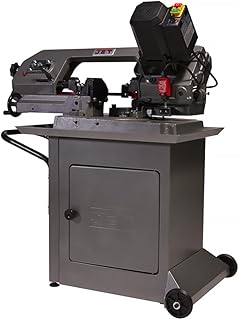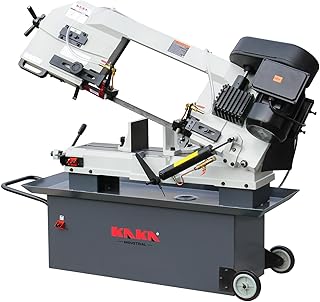When it comes to precision cutting, the best horizontal band saw can make all the difference in your workshop. If you’ve ever struggled with uneven cuts or slow performance, you know the frustration of using a subpar tool. But don’t worry—there are options that balance quality and affordability. For those looking for the best inexpensive band saw, you can find models that don’t compromise on durability. Meanwhile, enthusiasts working from home may benefit from the best home band saw, designed to fit compact spaces without sacrificing cutting power. Of course, for seasoned professionals, understanding the features that define the best band saw is crucial. Keep reading to explore top recommendations, practical tips, and expert insights that will help you make an informed choice for precise, efficient cuts.
Top Picks
Best Hydraulic: JET Tools - HVBS-712DV, 7" x 12" Variable Speed Deluxe Horizontal
The Jet 7" x 12" horizontal/vertical bandsaw with coolant system delivers a robust and versatile cutting experience for metalworking enthusiasts and small industrial shops. Its hydraulic downfeed feature ensures smooth, controlled cuts, reducing user fatigue while maintaining precision. The machine's adjustable toolless material stop allows for quick setup changes, which can save significant time when switching between tasks. The included stand with built-in storage cabinet and chip tray enhances organization, keeping tools and debris contained. Running at 270 RPM with a 1-horsepower motor, it handles iron and other metals efficiently, while the 24-tooth rectangular blade is suited for precise and consistent cuts. Certification under CSA/CUS standards assures safety and quality compliance.
From a user perspective, the Jet bandsaw appeals to those who prioritize durability and efficiency over portability. Its 418-pound weight limits mobility but contributes to stability during heavy cuts. Customers appreciate the hydraulic downfeed and storage features, which are often highlighted in reviews as game-changers for workflow. While not ideal for moving between job sites, in a workshop setting it provides reliability and a professional-grade cutting experience that balances performance with convenience.
Best Swivel: KAKA Horizontal Metal Band Saw with 10 inch x 7.9 inch Cutting
The KAKA Industrial 10 x 7.9 inch metal cutting bandsaw is designed for precise metalworking in small workshops or hobbyist setups. Its standout feature is the swivel head, which allows miter cuts up to 60 degrees, providing flexibility for angled cuts without the need for additional jigs. The raised base design improves stability and visibility during cutting, making it easier to work with smaller or intricate pieces. Equipped with a high-speed steel round blade and 24 teeth, it is capable of clean, accurate cuts on various metal surfaces. Its corded electric power source ensures consistent performance for prolonged use, while the compact footprint makes it suitable for limited workspace environments.
From a customer perspective, this bandsaw is ideal for those seeking precision in a lightweight, maneuverable tool. Users often note that while the power is modest, it is sufficient for smaller metal projects, and the swivel head greatly enhances versatility. The machine’s compact and European-style raised base design is appreciated for ergonomic convenience, although heavier or more demanding cutting tasks may exceed its capabilities. This tool is best suited for small-scale metal cutting tasks where precision and flexibility are prioritized over heavy-duty performance.
Best Versatile: VEVOR Metal Horizontal Band Saw, 7 x 8.25 in Rectangular Cutting Capacity
The VEVOR 7 x 8.25 inch metal horizontal bandsaw is engineered for both precision and adaptability in industrial and heavy-duty workshop environments. Its hydraulic downfeed provides controlled, smooth cutting, minimizing operator fatigue while maintaining accuracy. Adjustable speeds and angle adjustment features allow the saw to handle a wide variety of materials and cutting requirements, making it suitable for both straight and miter cuts up to 45 degrees. The automatic shut-off enhances safety during prolonged use, while the rectangular toothed blade ensures efficient, consistent cuts across different metals. With a robust 1100-watt motor and a rotating base design, it supports demanding metalworking tasks while offering flexibility in positioning.
From a user standpoint, this bandsaw is ideal for professionals who need versatility and precision in a single machine. Customers often highlight the hydraulic downfeed and adjustable speeds as major advantages, especially for repetitive or complex cuts. While its 408-pound weight and large footprint limit mobility, these factors contribute to stability and cutting consistency. Users appreciate its capacity to handle diverse materials and the ease of adjusting angles, making it a reliable and efficient solution for serious metalworking projects.
FAQs
What type of cut are horizontal band saws best for?
Horizontal band saws excel at straight, uniform cuts on metal, plastic, and dense wood materials. Unlike vertical band saws, they allow the workpiece to remain stationary while the blade moves downwards, which ensures consistent angles and reduces material movement. These saws are ideal for cutting pipes, bars, rods, and structural steel. They are particularly efficient for repetitive cuts where precision is critical, making them a staple in metalworking and fabrication shops.
What are the disadvantages of a horizontal band saw?
Despite their advantages, horizontal band saws have a few drawbacks. First, they tend to be larger and heavier, which makes them less suitable for small workshops. They also require more maintenance, including regular blade tension adjustments and lubrication to avoid wear. Additionally, setup can be time-consuming, especially when changing blade types or cutting at angles other than 90 degrees. Noise and vibration can also be higher compared to vertical models if the saw is not properly secured.
What is the 3-tooth rule for bandsaws?
The 3-tooth rule is a guideline for safe and efficient cutting with a bandsaw blade. It states that at least three teeth of the blade should be engaged in the material at any time. This ensures even cutting forces, reduces the risk of the blade binding, and promotes smoother cuts. Following this rule helps prevent premature wear on the blade and improves cutting accuracy, especially when working with thick or dense materials.
How to make a horizontal bandsaw cut straight?
Achieving straight cuts on a horizontal bandsaw requires a combination of proper setup and technique:
-
Secure the workpiece firmly in the vise to prevent movement.
-
Align the blade perpendicular to the material using the saw’s guide or fence.
-
Adjust blade tension according to the manufacturer’s recommendations to prevent drifting.
-
Use a steady feed rate—pushing too fast can deflect the blade, while too slow can burn the material.
-
Check blade sharpness and tooth type, as dull or inappropriate teeth can cause crooked cuts.
By combining these practices, you can consistently achieve straight, precise cuts with minimal adjustments.
Final Thoughts
Choosing the best horizontal band saw comes down to understanding your needs, material types, and desired cutting precision. While these saws offer unmatched accuracy for metal and dense wood, proper setup and maintenance are essential for optimal performance. Whether you’re seeking efficiency in a professional shop or a compact solution for home use, evaluating blade quality, cutting speed, and machine stability ensures reliable results. Investing in the right model can significantly improve productivity, accuracy, and safety in all your cutting projects.






















